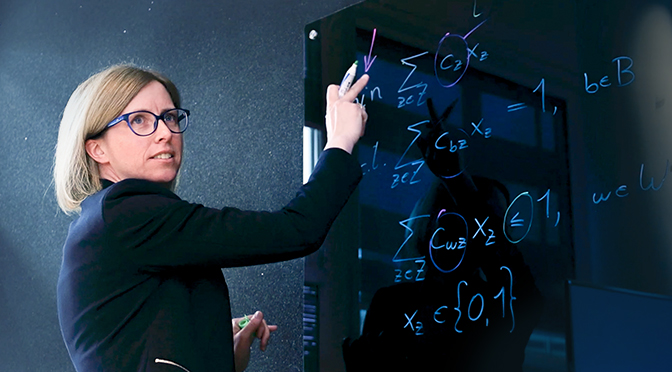It’s well known: There is a lack of women in STEM subjects and professions, yet girls and boys are equally strong in math at school. There are many reasons for this problem, and this too is well known. One reason why this female math strength is not more widely used is that there is a lack of ideas about what to do with interest in STEM subjects, specifically math. There is a lack – as is so often the case – of female role models. That’s why we met Sarah Frisch. She has a PhD in mathematics and works at Anexia as a software developer. Here we want to show together with her how to succeed in a career as a female mathematician.
Sarah didn’t choose the direct route either: “At school, math actually passed me by without a trace. I first started an apprenticeship as a cook and started a family. My interest in mathematics was awakened when I took my vocational matriculation examination. I simply enjoyed solving mathematical problems and thus decided to study technical mathematics. During my bachelor’s degree, however, I had no idea whether and how I could use what I had learned in my studies. There were hardly any practical examples among the many theoretical basics.
This changed when I specialized in discrete mathematics and came across Prof. Philipp Hungerländer. He deals with casting optimization problems from our daily lives into mathematical models and solving them. During a lecture he showed us examples from real life. That was my personal step into the real world!”
Sarah’s focus of studies is discrete mathematics. Discrete mathematics deals with coding theory, graph theory, and information theory. With the rapid development of our computers and their computing power, the tools from discrete mathematics can be used highly efficiently today and have therefore gained massive importance.
What does this mean in practice?
“We collect all the necessary information to specify the customer’s need and translate it into an abstract language. This allows the optimization problem from real life to be formulated with a mathematical model. It is about aspects like what should be maximized/minimized? (Costs, profit, resources, etc.) What are the constraints to be met? (Legal framework, technical constraints, social components, etc.) What information forms the basis (data!) and what should be the result?
Based on these requirements, suitable solution algorithms are designed, which are then implemented in a software.”
Since her PhD thesis, Sarah has been working with ÖBB on various projects from the dispatching department, since 2021 she works in these projects for Anexia. Dispatchers organize everything that is necessary for the transport of goods. They coordinate the distribution of goods as well as vehicle utilization. With their models, Sarah and her team can support the work of the dispatchers by showing the relationships and dependencies of the trains and the best solution can be output according to various parameters.
Translating real problems into the language of mathematics
Sarah’s task here is to create the mathematical equation.
“At the beginning of every project – including this one – there is always a business analysis. Without writing down a formula anywhere, I talk to my colleagues at ÖBB. As a mathematician, it is essential to build up a basic understanding of the respective industry and its processes. Talking to experienced dispatchers about how they make their decisions has proved particularly valuable in developing good models.
We collected all this information and then translated it into the language of mathematics. The dispatchers can now work with the result, the equation. They enter inputs and get different solutions at the push of a button, optimized according to the relevant aspects as described above, e.g.: costs, profit or resource utilization.”
And that’s exactly the point: Often, in college or school, you can’t quite figure out how to use theoretical models in a way that’s useful in practice. That’s what Sarah’s story is about – showing how math comes into practice. And it’s important to remember: Especially tech companies or software companies are not always looking for the classic developer alone – also other know-how like mathematicians is in high demand. Please have a look at our open positions at Anexia:
